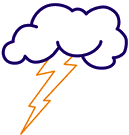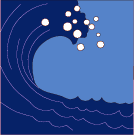 How's the
Weather?
How's the
Weather?
Goals:
- Students will learn characteristics and terms of ocean storms:
hurricanes, typhoons and tropical cyclones.
- Using various forms of media, the students will follow the
path of a tropical storm. (This is best done during the late
spring, summer and autumn months when ocean storms are at peak
intensity. Smaller ocean storms can be traced throughout the
year.)
- Students will read maps using longitude and latitude,
calculate distances from given map scales and locate places the
storm has passed, learning about the cultures in the storm's path.
- Students will develop their communication skills through
presentations.
Resources:
- The poem "The Sky and the Sea" by David T. Chappell (1993).
- Access to the Internet is essential for this project. Two
Internet sources are particularly beneficial for students. Basic
information about hurricanes, typhoons and tropical cyclones can
be found at
http://tropical.atmos.colostate.edu/text/tcfaq1.html
. To discover the paths of storms, actual up-to-date weather data
can be found from
http://banzai.neosoft.com/citylink/blake/tropical.html
- A copy of Jump Ship to Freedom by James Lincoln Collier
and Christopher Collier
- Brief video on the destruction a hurricane caused to a culture
(E.g. - Hurricane Hugo on the southeastern United States.)
- Access to newspapers and television will be helpful to record
the path of hurricanes.
- Maps of various parts of the world. Since Kidnapped and
Treasure Island are the underlying novels in the
curriculum, maps of the Atlantic Ocean surrounded by Africa,
Europe, North and South America would help students record the
storms path through the Atlantic Ocean and onto land. These maps
should have longitude and latitude lines.
- Library access to learn about various cultures in the storm's
path.
Time:
Besides being a lesson that would probably be best done during the
spring or autumn months, this lesson will require between ten and
fourteen hours of class time depending on the availability of
resources. (The introduction to hurricanes, typhoons and tropical
cyclones will take approximately one to two hours. This is followed
by finding storms via the Internet, taking about one to two hours.
This is followed by daily observations of the storm requiring thirty
minutes per day for the life of the lesson along with learning about
an affected culture which requires a minimum of four hours. In
conclusion, students will give presentations about the path of their
storms and the people affected by it.)
Procedure:
- To interest the students about ocean storms, read aloud the
poem "The Sky and the Sea" by David T. Chappell (1993) found on
the Internet. (See Resources)
- Read aloud the part of Jump Ship to Freedom pertaining
to the ship's trials through a hurricane. The passage runs from
page 53 ("'Is a storm coming?' I asked Birdsey.") to the top of
page 74 ("We'd ridden her out.")
- Through a brief discussion, ask students what they know about
ocean storms.
- Through direct instruction, introduce the concepts of
hurricanes, typhoons and tropical cyclones. The video showing
hurricane destruction may be appropriate here. Explain why these
are different than thunderstorms and tornadoes. Basic information
about these subjects can be found in the references section of the
lesson.
- Divide students into groups of three or four.
- Each team will receive a map of the Atlantic Ocean and the
lands surrounding it, allowing them a place to trace the path of
the storm. (If there are no major storms in the Atlantic Ocean,
other oceans can be used.)
- Students will use the Internet to receive up-to-date weather
data which allows them to chart the progress of their storm. This
will be done on a daily basis for the length of the lesson or the
length of the storm.
- As the storm approaches land, students will research
information regarding the people affected by the storm.
- The groups will present a five to ten minute presentation
characterizing their storm and background information about the
land and people affected by the storm.
Assessment:
- Each team must turn in a table listing the similarities and
differences between three types of ocean storms: hurricanes,
typhoons and tropical cyclones. (Criteria for success - Each team
must create a table having at least four similarities and
differences among the three types of ocean storms.)
- Using longitude and latitude lines, each team must turn in a
map with the storm's path and a copy of the materials used to plot
the storm's course (e.g. - Internet printout). (Criteria for
success - Each team must have correctly plotted the locations of
the storm's path and have the reference data for their plotted
points.)
- Each team must give a presentation about their storm and about
the land and people affected by the storm. (Criteria for success -
Each team must identify the type of storm, the type of land and
the cultural characteristics that give the students clues as to
the affect a similar storm or larger storm may have on the
culture. [e.g. conclusion - Mountainous terrain protects a
well-developed society.])
Curricular Strands and Major Concepts:
- Social Studies - Geography of the Atlantic Ocean,
reading maps and learning about other cultures affected by the
storm.
- Math - Understanding how to convert measured distance
on a map to actual distance.
- Science - Developing a basic knowledge of ocean storms
and the destruction they can cause.
- Language Arts - Development of oral communication
skills through the presentations.
Possible Extensions:
- Compare the destruction of a known tornado and a hurricane,
showing how people persevere through tough times.
- Explore the effects of storms on people. This does not just
have to be ocean storms.
- Learn about land storms and compare them to ocean storms not
only in physical characteristics, but also in the amount of
destruction causes.
Go to:
Schedule
and Summary of Lessons
Lesson Plans List
 How's the
Weather?
How's the
Weather?
 How's the
Weather?
How's the
Weather?